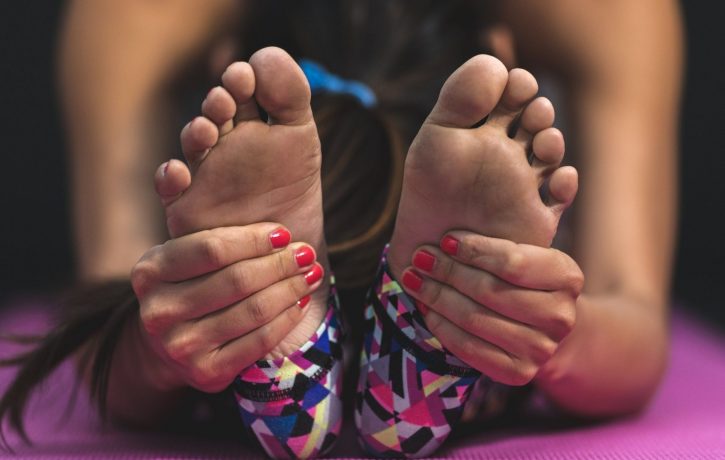in Joints & Muscles, Yoga & Pilates
Why Do I Get Muscle Cramps During Pilates and Yoga?

It is a question I get asked a lot. It tends to happen very commonly in specific situations such as during Pilates and the bridging exercise, where you lie on your back with your knees bent and lift your hips off of the floor. For some people that movement means instant Hamstring flame out and cramps in the back of the thigh. Another popular cramping trigger is lying face down and lengthening the legs away, reaching through the toes. Foot cramps are happy to overcome many people at this point. So why is this happening to so many people?
There are many things that can trigger cramps of course, so it is impossible to say for sure what is causing it at any given moment. To reduce the chances of muscle cramps in general you can do the following things:
- Make sure you stay well hydrated.
- Eat a banana or something else that is full of potassium.
- Tonic Water has quinine in it, which can help with acute cramps.
Of course, it is suspicious if your cramps always happen in the mentioned positions or exercises, so in those cases, there is something about the body attempting these movements that is at least a partial trigger.
In both of these movements, we are asking the body to get into a position it is not particularly accustomed to. In the bridge, we are attempting to open up the front of our hips, while also bending our knees. This is a big ask for our bodies, we would find it a lot easier to bend the knee when the hip is flexed. So what we are doing is, we are asking our soft tissues in the front of the hip and leg to lengthen in order to achieve the position. On the other side, our hamstrings and gluteus are keen to contract to get the job done. However, if the soft tissue in front is tight and struggling to let go we may find that the hamstrings, which notice the resistance from the other side start working harder to the point where they are overworking and go into a cramping spasm.
The same can be observed in the face-down lying position. As you lengthen the leg away you are asking the body to keep the front of the hip open and extend the long leg behind you. We don’t often have to do that in everyday life. As though that was not tough enough we are also asking the front of our ankle to open, another thing we don’t often do. How often do you spend time on your toes, especially with the leg behind the rest of your body?
So the same as before happens here, however here the issue appears in the foot or calf. As we start the movement we are putting the soft tissue in the front of our body on a degree of stretch, starting with the front of the hip. We continue to lengthen the tissues in the front of our leg all the way into the front of our foot. On the other side, the muscles in the calf and foot are doing their best to pull our leg into the position we want, however, if the soft tissue in the front of the hip or ankle is restricted the calf or foot may quickly complain that the job is too hard and go into spasm.
So what do we do about it? If you are experiencing these recurring cramps it is unfortunately a sign that ultimately you need to do more of these exercises so your body becomes more adaptable and capable of a variety of positions and movements. However, you want to help your body prepare for this.
- Mobilise your hip joints and stretch your hip flexors and quadriceps.
It may seem that we want to stretch the cramping muscles, and this will probably not harm the situation, however, the crucial thing to do is to mobilise and relax the soft tissue on the opposite side, the hip flexors, and quadriceps. Massage to these soft tissues can also be very helpful.
- Mobilise your ankle joints and feet.
For this, you can use a Dyna-band or a soft prickly ball. You want to make sure that your feet become comfortable in a variety of positions.
If you do this regularly and stay well hydrated and keep potassium levels up you should find that the cramping will diminish over time.
If you would like more support with this contact Kristin at The Body Matters on 01702 714968.
- The Thing About Mixed Feelings Is… - 4th June 2023
- Overthinkers – Here Is What You Really Need To Know - 28th April 2023
- Why Emotions Can Be Overwhelming - 13th December 2022
